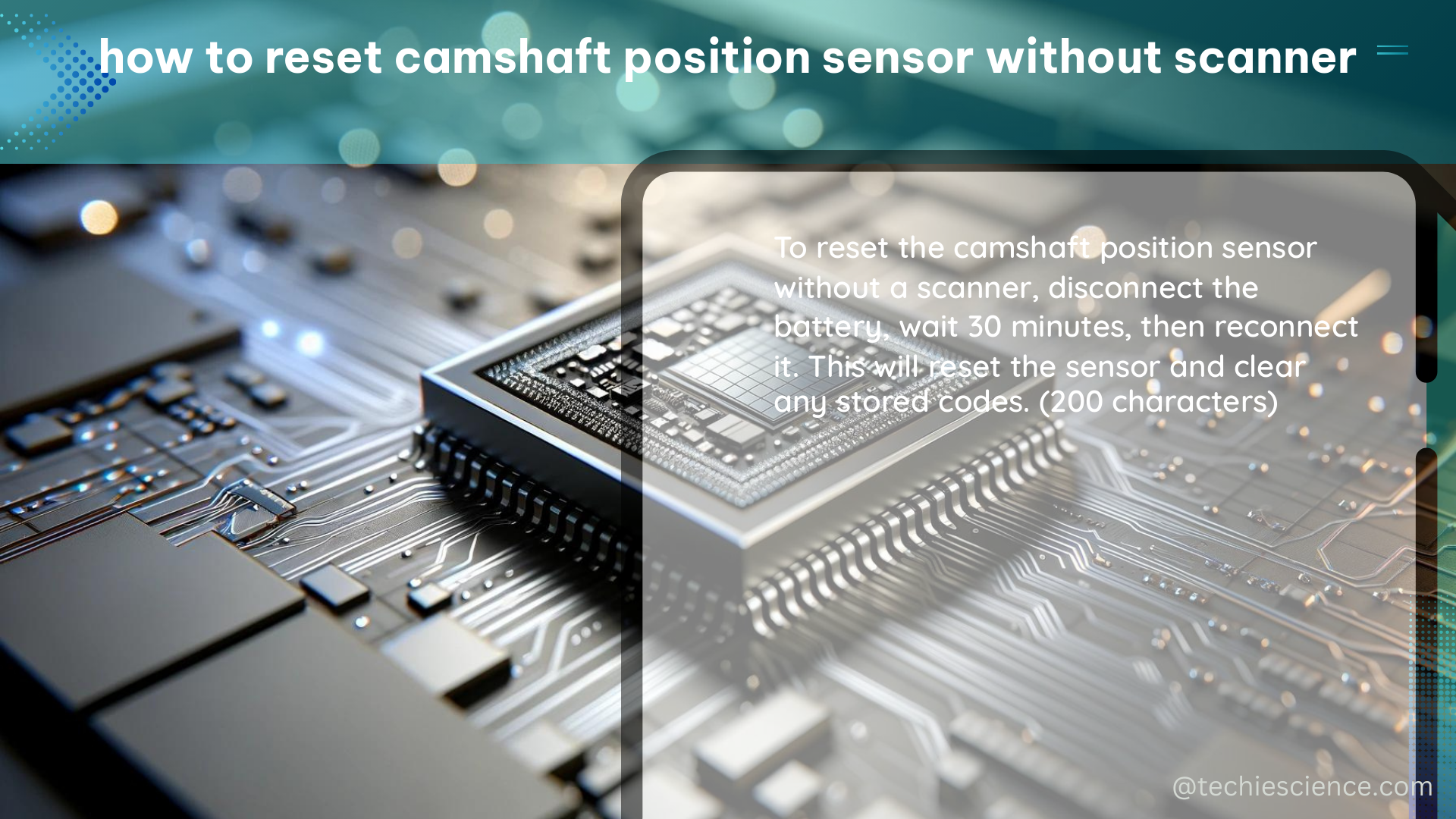Resetting a camshaft position sensor without a scanner can be a challenging task, but it’s not impossible. When a camshaft position sensor fails, it can cause various engine performance issues, such as misfiring, stalling, or difficulty starting. In some cases, you may be able to reset the sensor by disconnecting and reconnecting the battery cables, which can sometimes resolve the problem. This comprehensive guide will provide you with detailed steps, technical specifications, and measurements to help you reset your camshaft position sensor without the need for a scanner.
Understanding Camshaft Position Sensors
Camshaft position sensors are critical components in modern vehicles, responsible for monitoring the position and timing of the camshaft. These sensors typically measure the position of the camshaft in degrees of crankshaft rotation, which is essential for the engine’s proper operation.
Camshaft position sensors can use various technologies, including:
- Hall Effect Sensors: These sensors detect the magnetic field changes caused by the rotation of the camshaft, converting them into electrical signals.
- Variable Reluctance Sensors: These sensors measure the changes in magnetic reluctance as the camshaft rotates, generating an electrical signal.
- Magnetic Pickup Sensors: These sensors use a magnetic pickup to detect the movement of the camshaft, converting it into an electrical signal.
The resistance of a camshaft position sensor can vary, but it is typically in the range of 500 to 2000 ohms. The sensor’s location can also vary, as it may be positioned near the camshaft or in the distributor, depending on the vehicle’s design.
Preparing to Reset the Camshaft Position Sensor

Before attempting to reset the camshaft position sensor, you’ll need to gather the following tools and materials:
- Multimeter: A multimeter is essential for testing the sensor’s resistance and voltage output.
- Battery Disconnection Tool: This tool, often a wrench or pliers, will help you safely disconnect the battery cables.
- Protective Gloves and Eyewear: Wear gloves and safety glasses to protect yourself during the process.
Steps to Reset the Camshaft Position Sensor
- Disconnect the Battery Cables:
- Start by disconnecting the negative battery cable first, followed by the positive cable.
-
This step helps prevent any electrical damage to the vehicle’s computer system.
-
Wait for the System to Reset:
- After disconnecting the battery cables, wait for a few minutes to allow the vehicle’s computer system to reset.
-
This waiting period is crucial to ensure the system has enough time to clear any stored error codes or sensor data.
-
Reconnect the Battery Cables:
- Reconnect the positive battery cable first, followed by the negative cable.
-
Ensure the connections are secure and tight to prevent any issues.
-
Start the Engine:
- Start the engine and let it run for a few minutes.
-
During this time, observe the engine’s performance and check for any remaining issues related to the camshaft position sensor.
-
Verify the Reset:
- Use a multimeter to check the resistance of the camshaft position sensor.
- The resistance should be within the typical range of 500 to 2000 ohms.
- If the resistance is outside this range or the engine is still experiencing issues, the sensor may need to be replaced.
Troubleshooting Tips
If the above steps do not resolve the issue, consider the following troubleshooting tips:
- Check for Sensor Damage: Visually inspect the camshaft position sensor for any signs of damage, such as cracks, corrosion, or loose connections.
- Test the Sensor’s Voltage Output: Use a multimeter to measure the sensor’s voltage output while the engine is running. The voltage should be within the manufacturer’s specified range.
- Scan for Error Codes: If available, use a diagnostic scanner to check for any stored error codes related to the camshaft position sensor. This information can help identify the root cause of the problem.
- Consult the Vehicle’s Service Manual: Refer to the manufacturer’s service manual for specific instructions on resetting the camshaft position sensor for your vehicle model.
Technical Specifications and Measurements
Here are some additional technical specifications and measurements to consider when resetting a camshaft position sensor:
- Camshaft Position Sensor Location: The sensor may be located near the camshaft or in the distributor, depending on the vehicle’s design.
- Sensor Technology: The sensor may use Hall effect, variable reluctance, or magnetic pickup technology.
- Sensor Resistance Range: The resistance of the sensor is typically in the range of 500 to 2000 ohms.
- Sensor Voltage Output: The sensor’s voltage output should be within the manufacturer’s specified range, often between 0.5 and 4.5 volts.
- Sensor Mounting Torque: The sensor’s mounting torque should be checked and adjusted according to the manufacturer’s recommendations to ensure proper operation.
Conclusion
Resetting a camshaft position sensor without a scanner can be a challenging task, but with the right knowledge and tools, it is possible to achieve. By following the steps outlined in this comprehensive guide, you can troubleshoot and reset your camshaft position sensor, potentially resolving engine performance issues. Remember to always prioritize safety and consult the vehicle’s service manual for specific instructions related to your make and model.
References:
- How to Reset a Camshaft Position Sensor
- Camshaft Position Sensor
- How to Test a Camshaft Position Sensor

The lambdageeks.com Core SME Team is a group of experienced subject matter experts from diverse scientific and technical fields including Physics, Chemistry, Technology,Electronics & Electrical Engineering, Automotive, Mechanical Engineering. Our team collaborates to create high-quality, well-researched articles on a wide range of science and technology topics for the lambdageeks.com website.
All Our Senior SME are having more than 7 Years of experience in the respective fields . They are either Working Industry Professionals or assocaited With different Universities. Refer Our Authors Page to get to know About our Core SMEs.